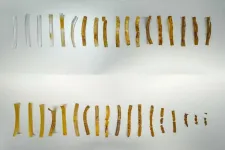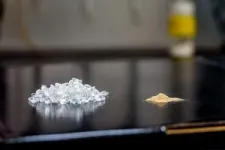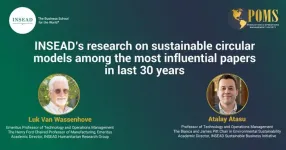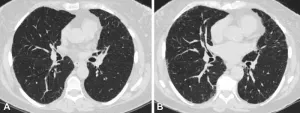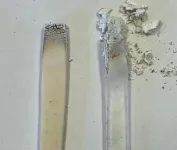(Press-News.org) A new type of bioplastic could help reduce the plastic industry’s environmental footprint. Researchers led by the University of California San Diego have developed a biodegradable form of thermoplastic polyurethane (TPU), a soft yet durable commercial plastic used in footwear, floor mats, cushions and memory foam. It is filled with bacterial spores that, when exposed to nutrients present in compost, germinate and break down the material at the end of its life cycle.
The work is detailed in a paper published on April 30 in Nature Communications.
The biodegradable TPU was made with bacterial spores from a strain of Bacillus subtilis that has the ability to break down plastic polymer materials.
“It’s an inherent property of these bacteria,” said study co-senior author Jon Pokorski, a nanoengineering professor at the UC San Diego Jacobs School of Engineering and co-lead of the university’s Materials Research Science and Engineering Center (MRSEC). “We took a few strains and evaluated their ability to use TPUs as a sole carbon source, then picked the one that grew the best.”
The researchers used bacterial spores, a dormant form of bacteria, due to their resistance to harsh environmental conditions. Unlike fungal spores, which serve a reproductive role, bacterial spores have a protective protein shield that enables bacteria to survive while in a vegetative state.
To make the biodegradable plastic, the researchers fed Bacillus subtilis spores and TPU pellets into a plastic extruder. The ingredients were mixed and melted at 135 degrees Celsius, then extruded as thin strips of plastic.
To assess the material’s biodegradability, the strips were placed in both microbially active and sterile compost environments. The compost setups were maintained at 37 degrees Celsius with a relative humidity ranging from 44 to 55%. Water and other nutrients in the compost triggered germination of the spores within the plastic strips, which reached 90% degradation within five months.
“What’s remarkable is that our material breaks down even without the presence of additional microbes,” said Pokorski. “Chances are, most of these plastics will likely not end up in microbially rich composting facilities. So this ability to self-degrade in a microbe-free environment makes our technology more versatile.”
Although the researchers still need to study what gets left behind after the material degrades, they note that any lingering bacterial spores are likely harmless. Bacillus subtilis is a strain used in probiotics and is generally regarded as safe to humans and animals—it can even be beneficial to plant health.
In this study, the bacterial spores were evolutionary engineered to survive the high temperatures necessary for TPU production. The researchers used a technique called adaptive laboratory evolution to create a strain that is resilient to extrusion temperatures. The process involves growing the spores, subjecting them to extreme temperatures for escalating periods of time, and allowing them to naturally mutate. The strains that survive this process are then isolated and put through the cycle again.
“We continually evolved the cells over and over again until we arrived at a strain that is optimized to tolerate the heat,” said study co-senior author Adam Feist, a bioengineering research scientist at the UC San Diego Jacobs School of Engineering. “It’s amazing how well this process of bacterial evolution and selection worked for this purpose.”
The spores also serve as a strengthening filler, similar to how rebar reinforces concrete. The result is a TPU variant with enhanced mechanical properties, requiring more force to break and exhibiting greater stretchability.
“Both of these properties are greatly improved just by adding the spores,” said Pokorski. “This is great because the addition of spores pushes the mechanical properties beyond known limitations where there was previously a trade off between tensile strength and stretchability.”
While the current study focused on producing smaller lab-scale quantities to understand feasibility, the researchers are working on optimizing the approach for use at an industrial scale. Ongoing efforts include scaling up production to kilogram quantities, evolving the bacteria to break down plastic materials faster, and exploring other types of plastics beyond TPU.
“There are many different kinds of commercial plastics that end up in the environment—TPU is just one of them,” said Feist. “One of our next steps is to broaden the scope of biodegradable materials we can make with this technology.”
Paper title: “Biocomposite Thermoplastic Polyurethanes Containing Evolved Bacterial Spores as Living Fillers to Facilitate Polymer Disintegration.” Co-authors include Han Sol Kim, Myung Hyun Noh, Debika Datta, Hyun Gyu Lim and Ehtan Smiggs, UC San Diego; Evan M. White, Michael V. Kandefer, Austin F. Wright and Jason J. Locklin, University of Georgia; and Md Arifur Rahman, BASF Corporation.
*These authors contributed equally to this work.
This work was supported by the U.S. Department of Energy’s Office of Energy Efficiency and Renewable Energy and Advanced Manufacturing Office (DE-EE0009296), UC San Diego Materials Research Science and Engineering Center (MRSEC) and the National Science Foundation (DMR-2011924).
END
Biodegradable ‘living plastic’ houses bacterial spores that help it break down
2024-04-30
ELSE PRESS RELEASES FROM THIS DATE:
Loneliness grows as we age
2024-04-30
Adults are lonelier in early and older adulthood, less lonely in middle adulthood
Consistent loneliness pattern found across nine longitudinal studies, all collected prior to COVID-19 pandemic
CHICAGO --- Loneliness in adulthood follows a U-shaped pattern: it’s higher in younger and older adulthood, and lowest during middle adulthood, reports a new Northwestern Medicine study that examined nine longitudinal studies from around the world.
The study also identified several risk factors for heightened loneliness across the whole lifespan, including ...
Listening to mindfulness audios during radiation improves physical, emotional side effects
2024-04-30
It’s a ‘twofer’: Helping men manage side effects, receive cancer treatment at same time
Men with cancer rarely participate in oncology supportive care: ‘You build it, and they don’t come’
First study to deliver mindfulness during radiation therapy while patients were ‘a captive audience’
CHICAGO --- Men with prostate cancer who are treated with radiation therapy experience significant side effects such as fatigue, sleep problems, anxiety and depressive symptoms. But listening to mindfulness audio recordings significantly eased those symptoms, a new Northwestern ...
INSEAD’s research on sustainable circular models among the most influential papers in last 30 years
2024-04-30
Studies by INSEAD Professors Atalay Atasu and Luk Van Wassenhove have been recognised by members of the Product Operations Management Society for their impact.
Their papers are named among the top 10 most influential papers published in the first 30 years of the Production and Operations Management (POM) journal. They were voted for by POM society members based on an original list of 150 of the most cited papers since the publications launch in 1992.
Emeritus Professor Van Wassenhove is a co-author of two papers that made the top 10. His 2005 paper, “Sustainable Operations Management” looked at ...
Quitting smoking during pregnancy may have a positive effect on placental weight
2024-04-30
The researchers in Bergen and Exeter used data from the Norwegian Mother, Father and Child Cohort Study (MoBa) and a similar study in the UK, the Avon Longitudinal Study of Parents and Children (ALSPAC), to investigate the relationship between smoking and placental weight. The aim was to determine to what extent expectant mothers who quit smoking could impact the weight of the placenta at the time of birth.
The study was recently published in the journal BMC Pregnancy and Childbirth.
Previous research has demonstrated ...
GPT-4, Google Gemini fall short in breast imaging classification
2024-04-30
OAK BROOK, Ill. – Use of publicly available large language models (LLMs) resulted in changes in breast imaging reports classification that could have a negative effect on patient management, according to a new international study published today in the journal Radiology, a journal of the Radiological Society of North America (RSNA). The study findings underscore the need to regulate these LLMs in scenarios that require high-level medical reasoning, researchers said.
LLMs are a type of artificial intelligence (AI) widely used today for a variety of purposes. In radiology, LLMs have already been tested in ...
Lung abnormality progression linked to acute respiratory disease in smokers
2024-04-30
OAK BROOK, Ill. – Smokers who have small abnormalities on their CT scans that grow over time have a greater likelihood of experiencing acute respiratory disease events, according to a new study published today in Radiology, a journal of the Radiological Society of North America (RSNA).
Quantitative interstitial abnormalities (QIA) are subtle abnormalities on chest CTs that do not meet the diagnostic criteria for advanced pulmonary diseases but are nonetheless associated with decreased ...
Innovation promises to prevent power pole-top fires
2024-04-30
Engineers in Australia have found a new way to make power-pole insulators resistant to fire and electrical sparking, promising to prevent dangerous pole-top fires and reduce blackouts.
Pole-top fires pose significant challenges to power providers and communities worldwide. In March, pole-top fires cut power from 40,000 homes and businesses in Perth.
The 2020 Royal Commission into National Natural Disaster Arrangements found that power outages experienced by 280,000 customers from various energy providers during Black Summer fires were mainly triggered by events involving insulators ...
Citizen scientists help discover record-breaking exoplanet in binary star system
2024-04-30
A team of astronomers and citizen scientists has discovered a planet in the habitable zone of an unusual star system, including two stars and potentially another exoplanet.
The planet hunters spotted the Neptune-like planet as it crossed in front of its host star, temporarily dimming the star’s light in a way akin to a solar eclipse on Earth. This ‘transit method’ usually identifies planets with tight orbits, as they are more likely to follow paths that put them between Earth and their host star and, when following such paths, move into light-blocking positions more frequently. That’s why this newly discovered planet is ...
Tambourine Philanthropies commits over $5 million in new funding for research into ALS, in partnership with the Milken Institute
2024-04-30
WASHINGTON, DC (April 30, 2024)—Tambourine Philanthropies (Tambourine), in partnership with the Milken Institute Science Philanthropy Accelerator for Research and Collaboration (SPARC), is pleased to announce the recipients of its ALS Breakthrough Research Fund. Tambourine has committed over $5 million total to eight teams around the world for basic and discovery-focused research aiming to change how we understand and treat amyotrophic lateral sclerosis (ALS).
Tambourine launched the ALS Breakthrough Research ...
E-bike incentives prove to be worth the investment
2024-04-30
Electric bicycle rebates have exploded in popularity in North America as transportation planners try to get people out of their cars and into healthier, more climate-friendly alternatives. However, there is limited understanding of the full impacts of these incentives.
Are new cycling habits sustainable? Who benefits most from these incentives? And are they worth the cost?
Researchers at UBC’s Research on Active Transportation (REACT) Lab have some answers. They surveyed participants in an e-bike incentive program offered by the District of ...
